Brewing Guides
Brew Perfectly: How to Make Coffee with Coffee Maker
Discover the art of brewing with our guide on how to make coffee with a coffee maker. Perfect your morning cup with ease and precision.

Want to know the secret to brewing the perfect cup of coffee? It’s simpler than you think. Forget about expensive gadgets and complicated techniques. All you need is a trusty coffee maker and the right knowledge. So, are you ready to discover the art of making coffee with a coffee maker?
Imagine waking up to the aroma of freshly brewed coffee, crafted just the way you like it. No more rushing to the coffee shop or settling for mediocre instant coffee. With a coffee maker at hand, you can have the perfect cup of joe, brewed to perfection, in the comfort of your own home.
In this comprehensive guide, we will walk you through the entire brewing process using a drip coffee maker. From choosing the right equipment to adjusting the brew strength and exploring different coffee types, we’ve got you covered.
So, whether you’re a coffee aficionado looking to improve your brewing skills or a coffee lover who wants to master the art of making coffee at home, this guide is for you. Get ready to unlock the secrets of brewing coffee with a coffee maker and elevate your coffee experience to new heights.
Key Takeaways:
- Using a coffee maker is a convenient and easy way to enjoy a delicious cup of coffee at home.
- With the right steps and techniques, you can brew the perfect cup of coffee every time.
- Choose the right equipment and understand how to adjust the brew strength for optimal results.
- Grinding fresh coffee and experimenting with different coffee types can enhance your coffee experience.
- Cleaning your coffee maker regularly is essential for maintaining the quality of your brew.
The Equipment You Need
To make coffee with a coffee maker, you will need a few essential items. These include:
- A coffee maker: This is the main equipment that will brew your coffee. Choose a reliable and user-friendly coffee maker for the best results.
- A coffee filter: Some coffee makers require a filter to separate the coffee grounds from the brewed coffee. Check the specifications of your coffee maker to determine if a filter is necessary.
- A mug: This is where you will pour and enjoy your freshly brewed coffee. Select a mug that suits your preferred coffee serving size.
- Water: Water is an essential ingredient for brewing coffee. Ensure that you have clean and fresh water available.
- A tablespoon: Use a tablespoon to measure the appropriate amount of ground coffee for your desired coffee strength.
- Your favorite ground coffee: Choose a high-quality ground coffee that matches your taste preferences. Experiment with different brands and flavors to find your perfect cup of coffee.
Having all these items ready before starting the brewing process will ensure a smooth and enjoyable coffee-making experience.
Brewing with a Drip Coffee Maker
The process of brewing coffee with a drip coffee maker is straightforward and convenient. By following these simple steps, you can enjoy a freshly brewed cup of coffee in no time.
Step 1: Add Water to the Reservoir
The first step is to add water to the reservoir of your coffee maker. Make sure to measure the correct amount using the markers on the machine. The reservoir is located at the back or side of the coffee maker, and it’s usually easy to access. Pour the water into the reservoir, ensuring that you add enough for the desired number of cups of coffee.
Step 2: Prepare the Coffee Filter
Next, it’s time to prepare the coffee filter. Place a coffee filter into the basket of the coffee maker. Ensure that the coffee filter fits properly and covers the entirety of the basket. The coffee filter helps to trap the ground coffee, ensuring a smooth and flavorful cup of coffee.
Step 3: Add Ground Coffee to the Filter
Now, add the appropriate amount of medium ground coffee to the coffee filter. The amount of ground coffee needed may vary depending on your personal taste preferences and the strength of the coffee you desire. It is generally recommended to use 1 to 2 tablespoons of ground coffee per 6 fl oz (180 ml) of water. Adjust the amount of coffee accordingly to achieve your preferred taste.
Step 4: Brew Your Coffee
With the water and coffee in place, it’s time to start the brewing process. Power on your coffee maker and wait for it to brew the coffee. The brewing time will vary depending on the coffee maker model and settings. Typically, it takes around 4 to 6 minutes for the brewing process to complete. During this time, the coffee maker heats the water and pours it over the ground coffee, extracting the flavors and oils to create a delicious cup of coffee.
Step 5: Pour and Enjoy
Once the brewing process is complete, carefully remove the carafe or mug from the coffee maker. Pour yourself a cup of the freshly brewed coffee and enjoy it while it’s still hot. Take a moment to savor the aroma and flavor of your homemade coffee. Sit back, relax, and let the rich taste of a perfectly brewed cup of coffee rejuvenate your senses.
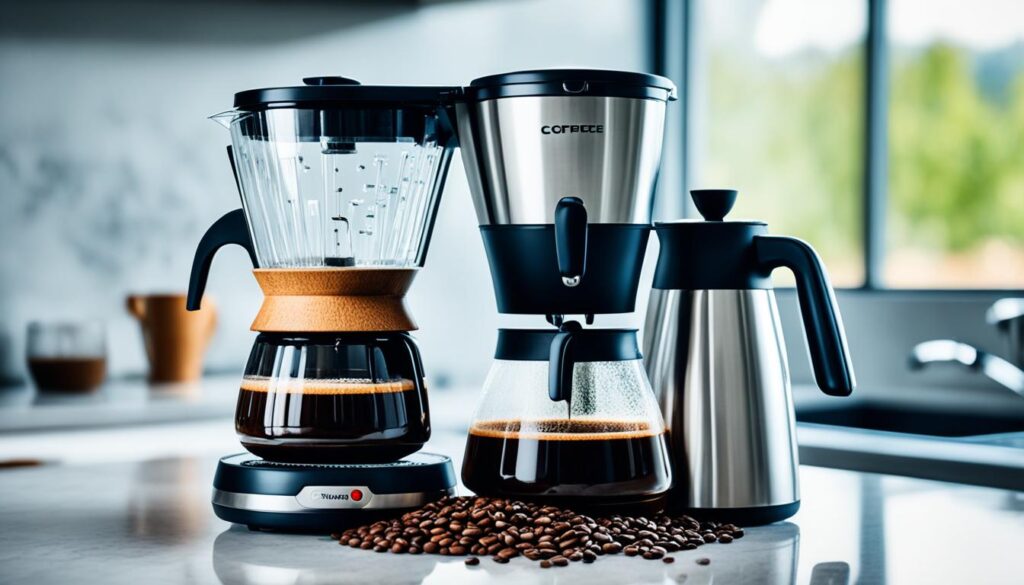
With these simple steps, brewing coffee with a drip coffee maker becomes a breeze. The convenience and efficiency of a coffee maker allow you to enjoy a delicious cup of coffee without the hassle of manual brewing methods. Experiment with different ground coffee varieties and adjust the water-to-coffee ratio to find the perfect balance for your taste buds. So why wait? Start brewing your favorite coffee today using your trusty drip coffee maker!
Tips for Brewing with a Coffee Maker
To ensure the best-tasting coffee, follow these helpful tips when brewing with a coffee maker. Always start with fresh water and use the appropriate amount according to your coffee maker’s instructions. It is recommended to use filtered water for the best taste.
When storing ground coffee, keep it in an airtight container away from sunlight, heat, and moisture to maintain its freshness. Proper storage ensures that the coffee retains its flavor and aroma.
Serve your coffee within 20 minutes of brewing for optimal flavor. If you’re not able to consume it right away, it’s best to transfer it to an insulated container to keep it hot. This prevents the coffee from becoming over-extracted or losing its heat.
Avoid reheating coffee as it can dull the flavor. Instead, brew a fresh cup when you’re ready for another serving. This ensures that you always enjoy the full richness of your coffee.
Why Fresh Water Matters
Using fresh water is crucial for brewing high-quality coffee. Water that has been sitting for too long may contain impurities or stale flavors that can affect the taste of your coffee. By starting with fresh water, you ensure that only clean, pure water comes into contact with your coffee grounds, allowing the natural flavors to shine through.
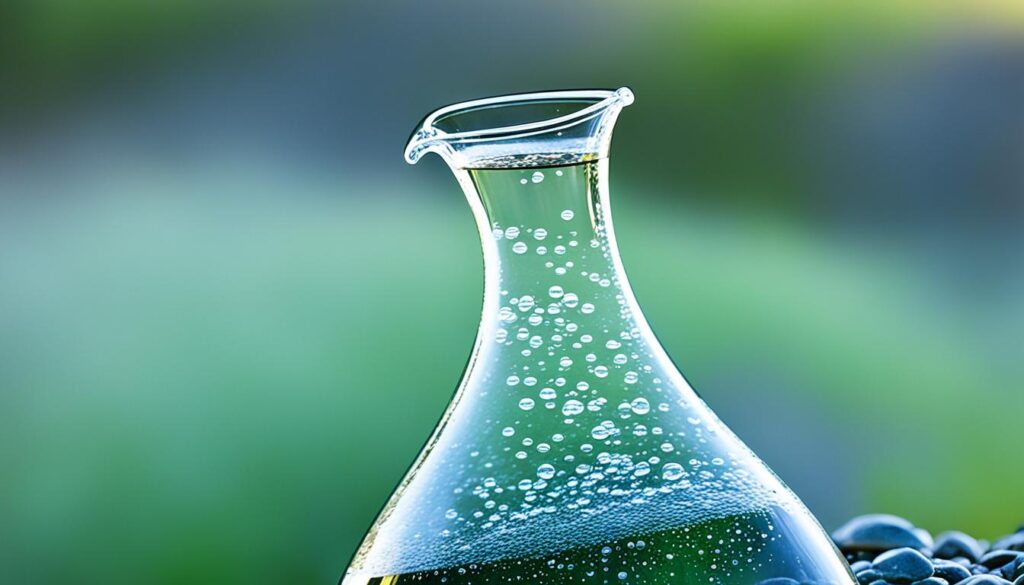
Adjusting the Brew Strength
Different coffee makers can have varying cup sizes, so it’s essential to understand how your specific coffee maker measures a “cup.” If you’re unsure, a simple method to determine the cup size is by measuring and pouring 12 fl oz (350 ml) of water into the reservoir. This will give you an accurate idea of the cup size measurement used by your coffee maker. Adjust the water and coffee measurements accordingly to achieve the desired strength and flavor.
Some coffee makers also feature a strength selector that allows you to customize the brew to your preference. This feature is particularly useful if you enjoy a stronger or milder cup of coffee. However, for most coffee makers, it is generally recommended to use the default setting for the best results.
Adjusting the Water and Coffee Measurements
To adjust the brew strength, you’ll need to modify both the water measurement and the coffee ground measurement. Here’s a simple guide to help you:
Strength Level Water Coffee Grounds Regular Standard cup size according to your coffee maker 1 tablespoon per cup Strong Use slightly less water than the standard cup size 1-2 tablespoons per cup Mild Use slightly more water than the standard cup size 3/4 tablespoon per cup
Keep in mind that these measurements are just guidelines, and you can adjust them further based on your personal preference. Be sure to experiment with different ratios until you find the perfect brew strength for your taste buds.
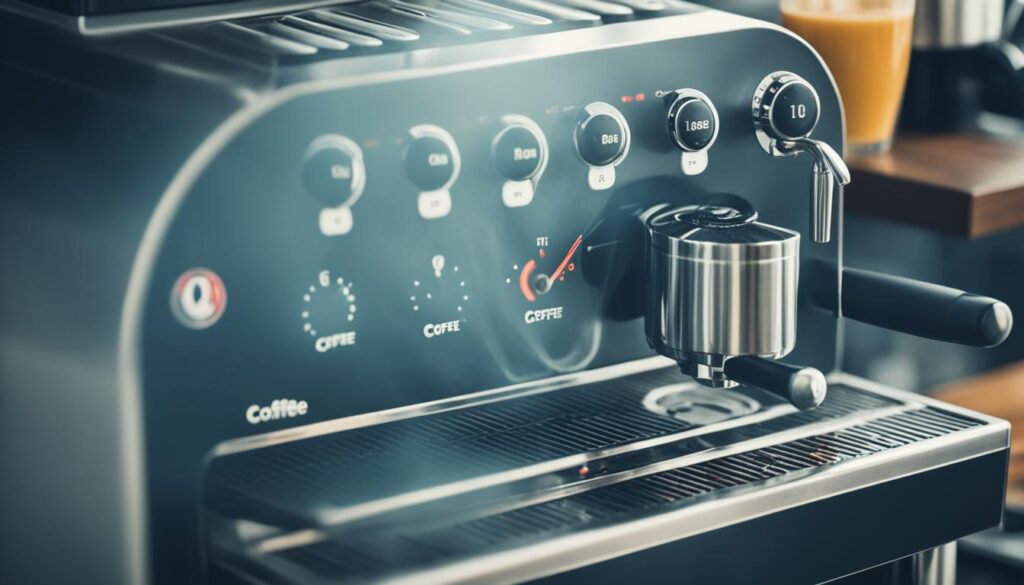
“Finding the ideal brew strength requires a delicate balance between water and coffee measurements. By making slight adjustments to these variables, you can create a cup of coffee that perfectly suits your taste.” – Justin, seasoned author, coffee and tea enthusiast, and an essential member of the Cappuccino Oracle team
Grinding Coffee for Your Coffee Maker
One of the essential steps in brewing a perfect cup of coffee with your coffee maker is grinding the coffee beans to the right size. This process greatly influences the flavor and aroma of your coffee.
For most drip coffee makers, a medium grind size is recommended. It strikes a balance between the coarser grind for French press and the finer grind for espresso. The medium grind allows the water to interact with the coffee grounds sufficiently, extracting the desired flavors without over-extraction.
If you own a coffee grinder, look for a specific “drip” setting. This setting is specifically tailored for drip coffee makers, ensuring that you achieve the optimal grind size. Alternatively, you can grind the coffee beans until most particles resemble the size of sand. This sand-like consistency allows for even extraction and a smooth cup of coffee.
If you prefer the convenience of pre-ground coffee, ensure that it is fresh and of high quality. Freshly ground coffee beans retain more of their flavors, resulting in a more flavorful brew. Look for whole bean coffee from reputable brands or local roasters and grind it just before brewing for the best results.
Remember, proper grinding and using fresh coffee are essential for unlocking the full potential of your coffee maker and enjoying a truly satisfying cup of coffee.

The Impact of Grind Size
The size of the coffee grounds plays a crucial role in the extraction process. Different grind sizes extract flavors at different rates, affecting the taste of your brewed coffee. Here’s a breakdown of how grind size impacts your coffee:
Coarse Grind: Coarse grind is recommended for methods like French press, where the coffee grounds are immersed in water for a longer time. The larger particles result in a slower extraction, producing a rich and bold cup of coffee.
Medium Grind: Medium grind is ideal for drip coffee makers. It allows for a balanced extraction, yielding a well-rounded and flavorful cup of coffee.
Fine Grind: Fine grind is commonly used for espresso machines or Moka pots. The fine particles increase the surface area for extraction, resulting in a concentrated and robust coffee flavor.
By adjusting the grind size based on your brewing method, you can optimize the flavor profile to match your preferences.
Cleaning Your Coffee Maker
Regular cleaning of your coffee maker is essential to maintain the quality of your brew and ensure a great tasting cup of coffee every time. Over time, oils and residue can accumulate, impacting the flavor of your coffee. By following a proper cleaning routine, you can keep your coffee maker in optimal condition and ensure a fresh and flavorful brew.
Refer to the Manual
When it comes to cleaning your coffee maker, it’s always best to consult the manufacturer’s manual for specific instructions. The manual will provide guidance on the recommended cleaning frequency and procedures for your particular coffee maker model. It may include step-by-step instructions, tips, and even cleaning solutions that are safe to use.
Regular Cleaning
To keep your coffee maker clean, start by removing any leftover coffee grounds or filters. Dispose of them properly. Then, use a mild dish soap or a coffee maker cleaning solution recommended by the manufacturer. Dilute the solution with water as instructed. Take care to clean all accessible parts of the coffee maker, such as the water reservoir, filter basket, and carafe.
Regular cleaning of your coffee maker is essential to remove any built-up oils and residue that can affect the taste of your coffee.
Pay special attention to any areas prone to oil or residue buildup, such as the spout, where oils can accumulate and impact the taste of your brewed coffee. Scrub gently using a soft brush or sponge, ensuring that you reach all the nooks and crannies of your coffee maker.
Descale Your Coffee Maker
In addition to regular cleaning, descaling your coffee maker is important to remove mineral deposits that can affect its performance and the taste of your coffee. Mineral buildup can occur over time, especially if you live in an area with hard water. Refer to your coffee maker’s manual for instructions on how to descale it properly using a descaling solution or a homemade vinegar solution.
Maintain the Taste of Your Coffee
Regular cleaning not only helps remove oils and residue but also ensures that your coffee maker continues to produce delicious-tasting coffee. By keeping your coffee maker clean, you can prevent the buildup of stale flavors and maintain the true taste of your coffee beans. It’s recommended to clean your coffee maker at least once a month, but more frequent cleaning might be necessary based on usage and water quality.
Remember, a clean coffee maker not only enhances the taste of your brewed coffee but also prolongs the lifespan and performance of your machine. So, make sure to incorporate regular cleaning into your coffee brewing routine for the best results.
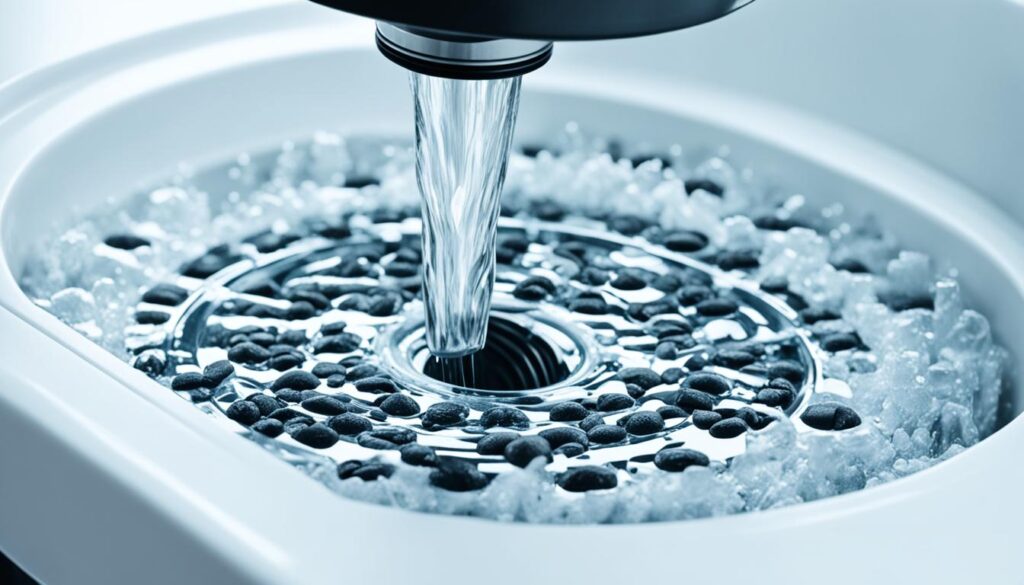
Using Different Coffee Types
Coffee makers are designed to work with various types of coffee, including whole beans and pre-ground coffee. However, for the best results, using freshly ground coffee beans is recommended to maximize flavor and aroma. Experiment with different types and flavors of coffee to find what suits your taste preferences best.
Whole beans are the preferred choice for coffee enthusiasts who value freshness and the ability to customize their grind size. When using whole beans, you have control over the grind, allowing you to adjust the coarseness to match your brewing method and personal preference. Grinding coffee beans just before brewing ensures that the flavors and aromas are at their peak.
Pre-ground coffee, on the other hand, offers convenience and simplicity. It is an excellent option for those who want a quick and hassle-free brewing experience. Pre-ground coffee is available in various grind sizes, catering to different brewing methods such as drip coffee makers.
Whether you choose whole beans or pre-ground coffee, the flavor and aroma of your coffee will depend on factors such as the coffee bean variety, roast level, and brewing technique. Try experimenting with different types of coffee to discover new flavors and aromas that excite your taste buds.
The Difference Between Drip Coffee and Pour-Over Coffee
Drip coffee and pour-over coffee are two different brewing methods that offer unique experiences for coffee enthusiasts. While both methods can produce delicious coffee, they differ in terms of the brewing process and the level of control over various variables.
Drip Coffee
In drip coffee brewing, a coffee maker with automatic brewing functionality is used to heat and dispense water over the coffee grounds. This method is convenient and requires minimal effort, making it a popular choice for many coffee lovers. The machine takes care of tasks such as heating the water to the appropriate temperature and regulating the flow rate.
With drip coffee, you can enjoy the simplicity of automatic brewing. It’s perfect for those who appreciate convenience and want a hands-off approach to making their morning cup of coffee. The automatic brewing process ensures consistency in water temperature, flow rate, and extraction.
Pour-Over Coffee
Pour-over coffee, on the other hand, involves manual pouring of hot water over the coffee grounds in a controlled manner. This method offers a more hands-on and interactive coffee brewing experience.
When making pour-over coffee, you have the freedom to control variables such as water temperature, flow rate, and coffee-to-water ratio. This level of control allows you to create a customized brewing process tailored to your taste preferences. You can experiment with different water temperatures and pours to bring out specific flavor notes in each coffee batch.
Pour-over brewing allows coffee enthusiasts to elevate their coffee experience by having greater control over water temperature and flow rate, resulting in a more nuanced and personalized cup of coffee.
Choosing Between Drip and Pour-Over
The choice between drip coffee and pour-over coffee ultimately depends on personal preference. If you value convenience and consistency, drip coffee brewing with its automatic brewing capabilities might be the ideal choice for you. On the other hand, if you enjoy having control over variables such as water temperature and flow rate to unlock unique flavor profiles, the pour-over method may be more appealing.
Both brewing methods offer their own advantages and can lead to exceptional coffee. Regardless of your choice, the most important factors in brewing a delicious cup of coffee are using high-quality beans and paying attention to the overall brewing process.

Explore the graphic showcasing the process of pouring water over coffee beans for a pour-over brewing method. The image depicts the manual pouring aspect of this brewing technique and reinforces the emphasis on control over water temperature and flow rate to achieve a personalized coffee experience.
Elevate Your Coffee Experience with Trade Coffee
If you’re looking to elevate your at-home coffee brewing routine, consider subscribing to Trade Coffee. With Trade, you can discover a curated selection of specialty coffees from top roasters across the country. Simply visit their website, take a quick quiz to indicate your flavor preferences and brewing equipment, and receive personalized coffee recommendations. Enjoy a world of delicious, freshly-roasted coffees delivered straight to your door.
Trade Coffee offers a convenient coffee subscription service that caters to your specific taste preferences. Whether you enjoy bold and full-bodied flavors or prefer a lighter and more nuanced cup, Trade has a wide range of options to satisfy every coffee lover.
With Trade, you have the opportunity to explore a variety of specialty coffees that you may not find at your local grocery store. Their network of roasters includes renowned names in the industry, ensuring that you’re getting the highest quality beans.
When you sign up for a coffee subscription with Trade, you’ll have the chance to select your preferred brewing method. Whether you use a drip coffee maker, a French press, or a pour-over method, Trade will recommend coffees that are best suited for your chosen brewing technique.
Trade Coffee takes the guesswork out of finding the perfect cup. Their coffee experts curate a selection of beans based on your flavor preferences, ensuring that you’ll always have an exceptional coffee experience. This personalized approach allows you to discover new flavors, expand your coffee palate, and truly savor every sip.
Don’t settle for mediocre coffee. Elevate your morning routine with Trade Coffee and indulge in the rich flavors and aromas of specialty coffees. Start your coffee subscription today and experience the joy of brewing exceptional coffee in the comfort of your own home.
Benefits of Trade Coffee Subscription
| Benefits | Details |
|---|---|
| Curated Specialty Coffees | Discover a selection of specialty coffees from top roasters across the country. |
| Personalized Flavor Preferences | Take a quiz to indicate your flavor preferences and receive personalized coffee recommendations. |
| Options for Every Brewing Method | Select your preferred brewing method and receive coffees best suited for your chosen technique. |
| Exceptional Coffee Experience | Expertly curated beans ensure that you’ll always have a high-quality and flavorful cup of coffee. |
| Expand Your Coffee Palate | Explore new flavors and expand your coffee horizons with an ever-changing selection of coffees. |
Get Started with Trade Coffee
- Visit Trade Coffee’s website.
- Take a quick flavor quiz to indicate your coffee preferences and brewing equipment.
- Choose a subscription plan that suits your needs and frequency of delivery.
- Select your preferred brewing method to receive coffees best suited for your technique.
- Sit back, relax, and await the arrival of your custom-curated specialty coffees.
Trade Coffee has revolutionized my morning routine. Their curated selection of specialty coffees has introduced me to flavors I never knew existed. I look forward to my monthly deliveries and savoring each cup.” – Charles, Trade Coffee subscriber & Strategic Editor in Chief

Conclusion
Making coffee with a coffee maker is a simple and enjoyable process. By following the steps outlined in this guide and implementing the tips from reputable sources like Starbucks, you can brew the perfect cup of coffee at home. Experiment with different coffee types, grind sizes, and brewing techniques to find the flavor profile that suits your taste preferences.
With practice and attention to detail, you can become a master of coffee brewing with a coffee maker. Whether you prefer a strong and bold brew or a smooth and aromatic cup, the possibilities are endless. Enjoy the satisfaction of creating your favorite coffee beverages right in your own kitchen.
Now that you have the knowledge and tools, it’s time to embark on your coffee brewing journey. Remember, each cup is an opportunity to explore and refine your skills. So grab your coffee maker, choose your favorite coffee, and start brewing the perfect cup of joe for yourself and your loved ones. Cheers!
FAQ
What do I need to make coffee with a coffee maker?
How do I brew coffee with a drip coffee maker?
How can I ensure the best-tasting coffee when brewing with a coffee maker?
How do I adjust the brew strength on my coffee maker?
What grind size should I use for drip coffee makers?
How often should I clean my coffee maker?
Can I use different types of coffee with a coffee maker?
What’s the difference between drip coffee and pour-over coffee?
How can I elevate my at-home coffee brewing routine?

French Press
Clean Brew: How to Avoid Coffee Grounds in French Press!
Avoid coffee grounds in your French press with these essential tips to enjoy a smoother, cleaner cup of coffee.

To avoid coffee grounds in your French press, try these tips: Use a coarser grind setting to minimize grounds. Consider a burr grinder for consistent grinding. Secure the screen properly to prevent escapes. Plunge gently to keep grounds settled at the bottom. Let coffee settle post-brew for a cleaner cup. Try paper filters for a smoother taste. Improving these aspects will help you enjoy a cleaner French press coffee experience.
Key Takeaways
- Use a coarser grind setting to minimize grounds in French Press.
- Ensure a secure screen fit for cleaner brews.
- Apply gentle plunging pressure to keep grounds settled.
- Let coffee settle post-brew for enhanced taste.
- Consider paper filter alternatives for a grit-free cup.
Coarser Grind for Minimized Grounds
To minimize sediment in your French Press brew, opt for a coarser grind setting on your coffee grinder. When using a blade grinder, achieving a consistent coarse grind can be challenging. An upgrade to a burr grinder is recommended for a more uniform coarse grind that reduces the presence of sediment in your coffee.
Ensure that your French Press screen fits securely to prevent any sediment from escaping into your brew. Regularly inspect and clean your French Press filter to maintain ideal brewing conditions.
Experiment with different grind sizes to find the right balance for a cleaner cup of coffee. By adjusting the grind size, you can control the extraction process and minimize the amount of fine particles that end up in your French Press brew.
Upgrading to Burr Grinder for Precision

Considering the benefits of precise grinding in French press brewing, what key advantage do burr grinders offer over blade grinders?
When you upgrade to a burr grinder for your French press coffee, you ensure a consistent grind size that's essential for an even extraction. Burr grinders are designed to reduce fines and sediment in your brew, resulting in a cleaner cup of coffee.
With uniformity in grind size, burr grinders provide the precise grinding needed for a high-quality and clear French press coffee. Unlike blade grinders, which may not achieve the coarse grinds required for French press brewing, burr grinders offer the reliability and accuracy necessary to enhance your coffee experience.
Investing in a burr grinder with two mounted bearings can notably improve the overall quality of your French press coffee by delivering a consistent and precise grind every time.
Ensuring Secure Screen Fit
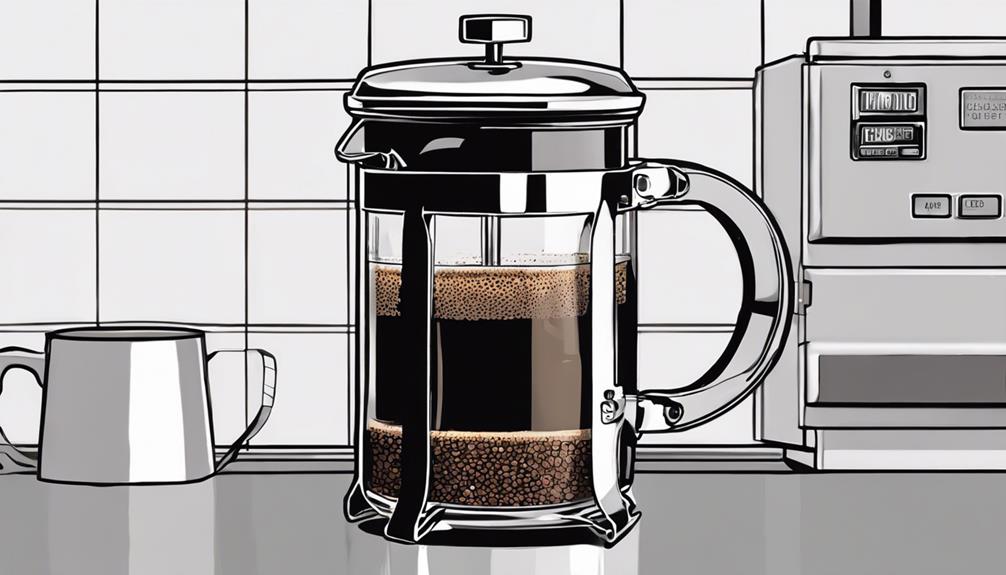
Examine the screen carefully to secure a snug fit, preventing coffee grounds from escaping during the French press brewing process. When the screen fits well, it acts as a barrier to halt grounds from passing through, resulting in a cleaner brew with minimal sediment in your final cup of coffee. A firm fit guarantees that the grounds remain contained within the press, enhancing the overall coffee-drinking experience.
To achieve a firm fit, regularly check the screen and make any necessary adjustments. Loose screens can allow grounds to seep through, leading to unwanted residue in your coffee. By verifying the screen is properly fitted, you can enjoy a smoother, grit-free brew that highlights the flavors of your coffee beans.
Remember that maintaining a secure screen fit is essential in producing a delicious and satisfying cup of French press coffee.
Gentle and Even Plunging Technique
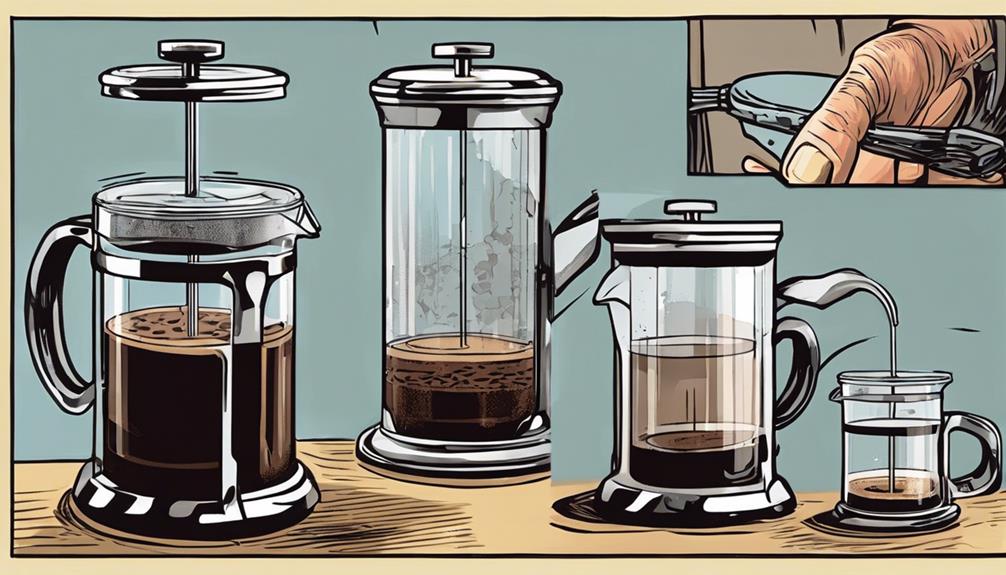
When plunging your French press, remember to apply gentle and even pressure. This technique helps to keep the grounds settled at the bottom, ensuring a cleaner cup of coffee.
Plunging Pressure Control
To ensure minimal coffee grounds in your French press brew, master the art of applying gentle and consistent pressure during the plunging process.
When pressing down the plunger, make sure you maintain even pressure throughout to avoid any grounds from escaping into your coffee. Jerky movements or sudden pauses can cause the grounds to slip through the filter, affecting the purity of your brew.
By steadily and gently pressing down, you help the grounds stay settled at the bottom, resulting in a cleaner cup of coffee. The key is to control the plunging pressure to prevent any fine grounds from passing through the filter and altering the texture of your beverage.
Grounds Settling Time
After gently and evenly pressing down the plunger in your French press, allowing the coffee to sit for a minute aids in the settling of grounds at the bottom of the brewer. This essential grounds settling time is when the press screen effectively traps any lingering particles, preventing them from floating around and ending up in your cup.
Your patience in this moment guarantees that the grounds stay at the bottom of the press, allowing you to pour a clean brew without any unwanted bits in your last sip.
Allowing Coffee to Settle Post-Brew

Allow the freshly brewed coffee in your French press to settle for a minute to let the grounds sink to the bottom, enhancing your overall coffee experience.
Allowing the coffee to settle post-brewing is important in minimizing the amount of grounds that end up in your cup. This short settling period not only helps in reducing grit but also greatly improves the taste and texture of your coffee.
By patiently letting the brew rest after pressing, you ensure a smoother and more enjoyable drinking experience, free from unwanted sediment.
The act of letting your coffee settle post-brew doesn't just eliminate the hassle of dealing with grounds in your cup; it also enriches the flavor profile of your coffee. Taking this extra moment of patience contributes to a richer, more satisfying coffee experience, enhancing the overall quality of your French press brew.
Exploring Paper Filter Alternatives
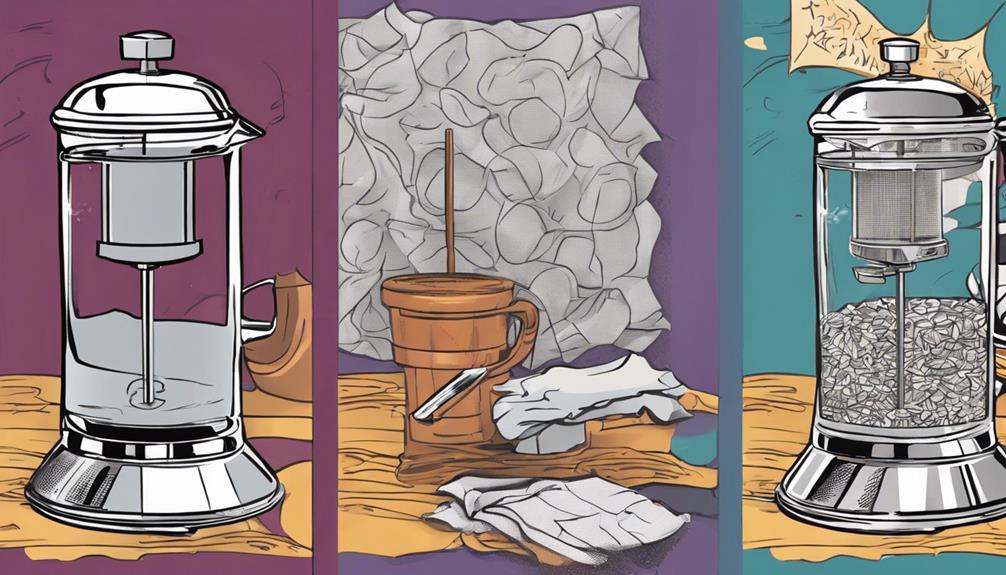
Consider trying paper filters as a grit-free alternative to traditional French press brewing methods. When exploring paper filter alternatives, keep in mind the following:
- Removal of Oils: Paper filters effectively eliminate oils that can affect the flavor profile of your coffee, providing a cleaner and purer taste.
- Richness Alteration: Using paper filters may result in a slightly different richness compared to metal filters, allowing you to experiment and find the balance that suits your preference.
- Cleaner Cup: Incorporating paper filters into your French press routine can lead to a cleaner cup of coffee by minimizing the presence of grounds, enhancing the overall drinking experience.
- Minimized Grounds: Paper filters offer a simple solution to minimize the amount of grounds that end up in your coffee, ensuring a smoother texture and a more enjoyable brew.
Embracing paper filters in your French press brewing process can help you achieve a cleaner and more refined coffee experience, free from unwanted grit and with a focus on enhancing the flavors.
Avoiding Bitter Dregs Consumption
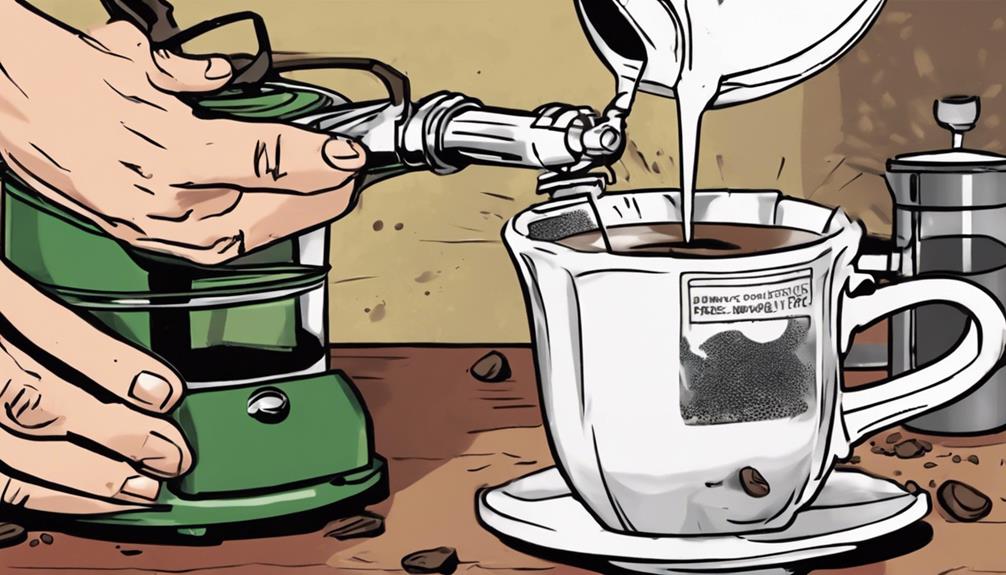
To prevent the unpleasant taste of bitter dregs in your French press coffee, refrain from ingesting the settled grounds at the bottom of your cup. When you reach the last sip, resist the urge to finish it to steer clear of a bitter and gritty experience.
Instead, focus on savoring the smooth and flavorful part of your brew. By avoiding the consumption of the fine grounds at the bottom, you can guarantee your cup of French press coffee remains free from grit and enjoyable.
If you find yourself facing bitter dregs, consider making a fresh brew to experience the full richness of your coffee without the unwanted aftertaste. Remember, a little restraint can lead to a much more satisfying coffee-drinking experience.
Transitioning to AeroPress Brewing
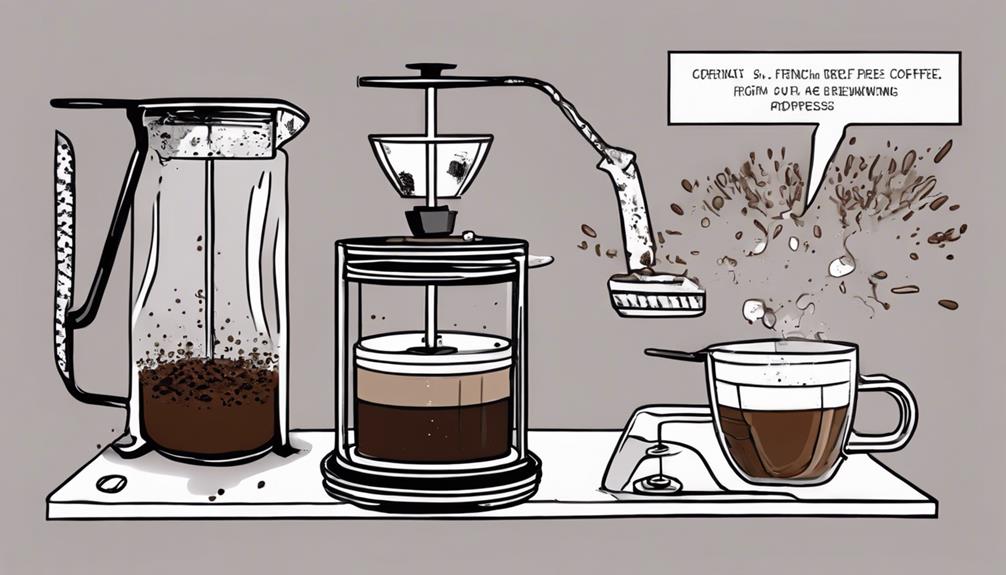
Thinking about switching to AeroPress brewing?
You'll love the affordability and quality it offers.
Let's explore the benefits and techniques of AeroPress brewing together.
AeroPress Benefits
Switching to the AeroPress offers a cost-effective and versatile alternative to French Press brewing, providing a rich and smooth coffee experience with the added benefit of avoiding coffee grounds in your cup.
Here are some benefits of the AeroPress:
- Affordability: Priced at $39.95, the AeroPress is a budget-friendly option compared to other brewing methods, making it accessible to coffee enthusiasts of all levels.
- Rich Coffee: The AeroPress produces a flavorful and full-bodied cup of coffee, ensuring a satisfying coffee experience every time you brew.
- Versatility: With the ability to make various styles of coffee such as American, Espresso, and Cold brew, the AeroPress caters to different preferences and occasions.
- Grit-Free Brewing: Thanks to its innovative brewing method, the AeroPress minimizes the presence of coffee grounds in your cup, providing a cleaner and more enjoyable coffee drinking experience.
AeroPress Brewing Techniques
When shifting to AeroPress brewing, you can explore different techniques that enhance your coffee experience and provide a grit-free cup every time.
Priced at $39.95, the AeroPress offers an economical alternative to the French Press, delivering rich and smooth coffee perfect for both home and on-the-go brewing.
With the AeroPress, you can easily create American, Espresso, and Cold brew coffee, catering to your preferences effortlessly. This brewing method guarantees a cleaner cup compared to the French Press, giving you a smoother coffee experience.
The AeroPress's design allows for a grit-free outcome, similar to the French Press but with a cleaner finish. Whether you're looking for a quick and convenient way to brew at home or while traveling, the AeroPress provides a versatile and effective brewing solution.
Say goodbye to coffee grounds and hello to a flavorful, grit-free cup of coffee with the AeroPress.
Frequently Asked Questions
How to Avoid Coffee Grounds in French Press?
Want to dodge coffee grounds in your French Press? Opt for a coarser grind size and a snug screen fit. Let the brew settle for a minute post-press. Invest in a burr grinder for consistency. For grit-free coffee, consider a paper filter.
How to Prevent Sediment in French Press Coffee?
To prevent sediment in your French press coffee, adjust the grind size to coarse, skim the surface before pressing, and pour through a fine mesh strainer. Experiment with brewing techniques like the French Pull. Consider devices like The French Kiss for easier cleanup.
How to Remove Coffee Grounds From a French Press?
Want to remove coffee grounds from your French press? Try these tips: Use a fine mesh sink strainer, employ the French Pull method, consider tools like The French Kiss or Espro Press, or attempt the no-press technique.
How to Avoid Getting Coffee Grounds in Coffee?
To avoid getting coffee grounds in your cup, use a coarser grind size, upgrade to a burr grinder, or try a paper filter. Press the plunger gently and let the coffee settle after pressing. Enjoy a smoother brew!
Conclusion
By following these tips, you can enjoy a clean brew with minimal coffee grounds in your French press.
Remember to:
- Use a coarser grind
- Upgrade to a burr grinder
- Confirm a secure screen fit
- Plunge gently and evenly
- Allow the coffee to settle
- Explore paper filter alternatives
- Avoid bitter dregs
- Consider shifting to AeroPress brewing for a smoother cup of coffee
Happy brewing!
French Press
How Does a Coffee Press Work in 10 Steps
You won't believe how easy it is to master a coffee press with these 10 simple steps—discover the secrets to perfect coffee now!
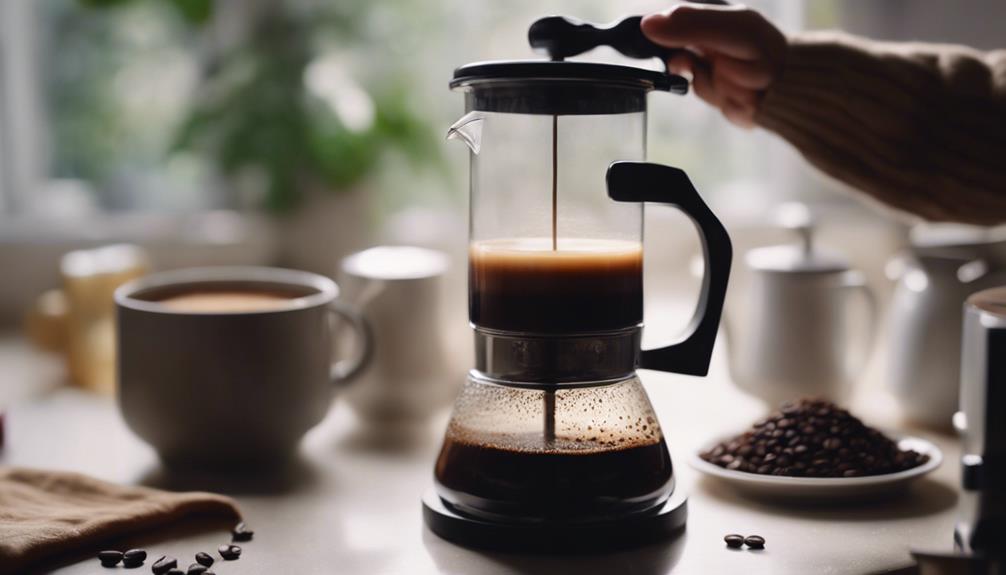
To use a coffee press effectively, gather your materials: coffee beans, water, press, beaker, and plunger with a filter. Measure 51g of coarsely ground coffee beans. Boil water to 195-200°F and preheat the press by rinsing it with hot water. Add coffee grounds to the press, then pour hot water over them slowly, ensuring even coverage. Stir the mixture immediately to distribute the grounds uniformly. Let the coffee steep for about 4 minutes, then gently press the plunger down to separate the grounds. Serve the freshly brewed coffee promptly for best flavor. For more detailed steps, stay engaged.
Key Takeaways
- Measure ½ cup of coarse coffee grounds for optimal extraction.
- Heat water to 195-200°F to avoid bitterness and enhance flavor.
- Preheat the coffee press to maintain stable brewing temperature.
- Pour hot water slowly over the coffee grounds, then stir for even saturation.
- Steep for 4 minutes, then gently press the plunger to separate grounds and serve immediately.
Gather Your Materials
To start, gather your coffee beans, water, and the coffee press. These materials are essential for making a delicious cup of coffee using a press.
The coffee press, also known as a French press, relies on immersing coarsely ground coffee beans in hot water to extract the rich flavors and oils from the beans.
Begin by ensuring you have high-quality coffee beans. The flavor of your coffee greatly depends on the beans you choose.
Next, prepare your water. The ideal temperature for brewing coffee in a press is just below boiling, around 200 degrees Fahrenheit. This temperature helps extract the best flavors without burning the coffee.
The coffee press itself is a straightforward device. It consists of a cylindrical beaker, a plunger with a metal or plastic mesh filter, and a lid.
The coarse grind of the coffee is crucial because finer grinds can clog the filter and result in a gritty, over-extracted brew. When you immerse the coarsely ground coffee in hot water, the flavors and oils are extracted efficiently, and the plunger helps separate the grounds from the brewed coffee, giving you a smooth and flavorful cup.
Follow these steps, and you'll be on your way to enjoying a perfect coffee press experience.
Measure Coffee Grounds
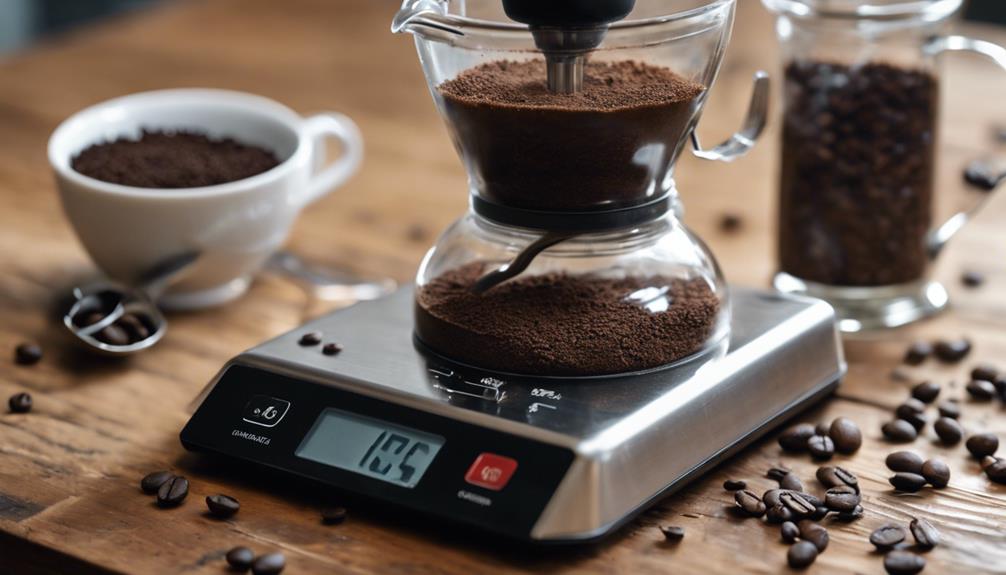
Once you've gathered your materials, the next step is to measure ½ cup (51 g) of coffee beans accurately. Accurate measurement of coffee grounds is important to guarantee the right strength and flavor in your coffee. Use a kitchen scale for precision, as it provides a more reliable measurement than using a standard measuring cup.
After you've measured the coffee beans, it's important to grind them to a coarse grind. A coarse grind is essential for a French press because it allows for proper extraction and prevents the grounds from slipping through the mesh filter.
Next, consider the coffee-to-water ratio, which is typically 1:8 for a standard French press. This ratio means for every one part of coffee, you should use eight parts of water. By adhering to this ratio, you can control the coffee's strength and flavor, ensuring a consistently delicious cup each time you brew.
Here's a quick reference table for measuring coffee grounds:
| Coffee Beans | Coarse Grind | Coffee-to-Water Ratio |
|---|---|---|
| ½ cup (51 g) | Essential | 1:8 |
| Accurate Measurement | Proper Extraction | Consistent Flavor |
| Use Kitchen Scale | Prevents Grounds in Coffee | Control Strength |
| Precision Matters | Mesh Filter Compatibility | Delicious Brew |
Boil Water
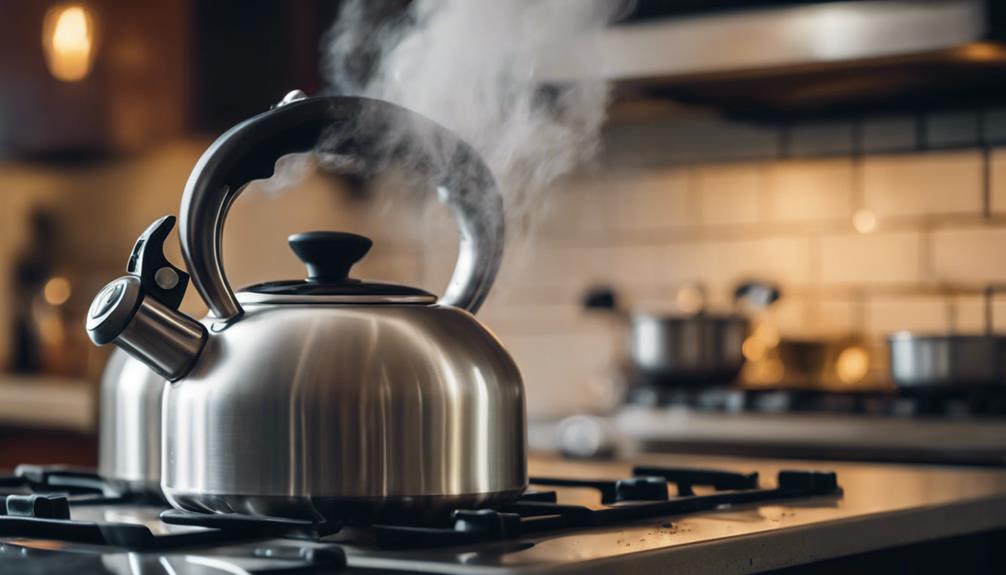
Heating your water to the correct temperature is essential for brewing a perfect cup of coffee with a French press. When boiling water for your coffee press, aim for a temperature between 195°F and 200°F. This range ensures ideal brewing, as water that's too hot, such as a rolling boil at 212°F, can result in a burnt taste in your coffee. Utilizing a kettle with a temperature setting can help you achieve the precise water temperature needed.
Preheating water before adding it to your coffee press can greatly enhance the extraction process. Preheating ensures that the hot water you pour over the coffee grounds maintains a consistent temperature, which is important for even saturation and flavor extraction.
Gradually adding hot water to the coffee grounds helps to evenly saturate them, allowing for a balanced and rich flavor profile.
Preheat the Press

Preheating the coffee press is essential for maintaining the ideal water temperature, which guarantees consistent heat exposure during brewing.
By rinsing the press with hot water before adding the coffee grounds and water, you prevent rapid cooling that can adversely affect flavor extraction.
Skipping this step may result in temperature fluctuations, impacting the quality and taste of your coffee.
Importance of Preheating
To get the best flavor from your coffee, it's important to preheat the press to maintain the ideal brewing temperature. Preheating is vital because it helps achieve the perfect brewing temperature, ensuring that the coffee grounds extract their full range of flavors.
When you preheat the press, you reduce heat loss that can occur during the brewing process. This stability in temperature results in a more consistent and flavorful cup of coffee.
Skipping this step can lead to unexpected temperature fluctuations, which negatively affect the final taste of your coffee. The initial contact between the hot water and the cold press can cause the water temperature to drop quickly, undermining the flavor extraction process.
Preheating the press is a simple yet essential step that can greatly enhance your overall coffee experience by maintaining the right conditions for brewing.
Optimal Water Temperature
Maintaining an ideal water temperature of around 200°F is crucial for extracting the best flavors from your coffee grounds. Preheating your coffee press is a critical step in achieving this ideal temperature. When you preheat the press, you minimize heat loss that can occur once you add the hot water to the coffee grounds. This practice guarantees that the water temperature remains stable throughout the brewing process, leading to better flavor extraction.
To preheat your coffee press, simply fill it with hot water and let it sit for a few moments before discarding the water. Doing so warms the press, reducing the likelihood of significant temperature drops when you introduce the brewing water.
It's noteworthy that using boiling water, which is typically around 212°F, should be avoided as it can result in a burnt taste, detracting from the coffee's natural flavors.
Retaining Coffee Flavors
Warming up your coffee press is a simple yet effective step to guarantee you get the most flavorful cup of coffee. Preheating the press ensures that the coffee grounds experience a stable brewing temperature, which is essential for retaining coffee flavors. When you pour hot water into the press before adding coffee grounds, you prevent significant heat loss that could otherwise impact the extraction process.
Here's a quick overview of the benefits:
| Benefit | Explanation |
|---|---|
| Retaining Coffee Flavors | Maintains ideal brewing temperature |
| Preventing Heat Loss | Secures steady temperature during brewing |
| Avoiding Temperature Shock | Warms the glass to prevent flavor disruption |
| Consistent Extraction | Guarantees a uniform and flavorful extraction |
| Enhanced Taste | Creates a perfect brewing environment |
Preheating also prevents temperature shock, which can negatively affect the taste of your coffee. By warming up the glass, you create a consistent environment that contributes to a more flavorful extraction. This simple step helps to ensure that all the nuanced flavors within the coffee grounds are fully developed and carried through into your cup.
Add Coffee Grounds

Add coarse ground coffee to the coffee press chamber to kickstart your brewing process. Using a French press requires precision in selecting the coffee grounds; coarse grounds are best for extracting rich flavors without over-extraction. The coffee-to-water ratio is important for achieving the perfect cup, with a standard recommendation of 1:16. This means for every gram of coffee, you should use 16 grams of water. Making sure that your coffee grounds are evenly distributed in the press is essential for a consistent brew.
Freshly ground coffee beans greatly enhance the flavor profile of your French press brew. When coffee beans are ground just before brewing, they retain more of their essential oils and aromatic compounds, leading to a more flavorful and aromatic cup. The amount of coffee grounds you use will directly affect the strength of your brew; more grounds will yield a stronger, more robust flavor, while fewer grounds will result in a milder taste.
Distribute the coffee grounds evenly across the bottom of the press chamber. This even distribution helps to make sure that the water can saturate all the coffee grounds equally, providing a balanced extraction and a well-rounded flavor profile in your final brew.
Pour Hot Water
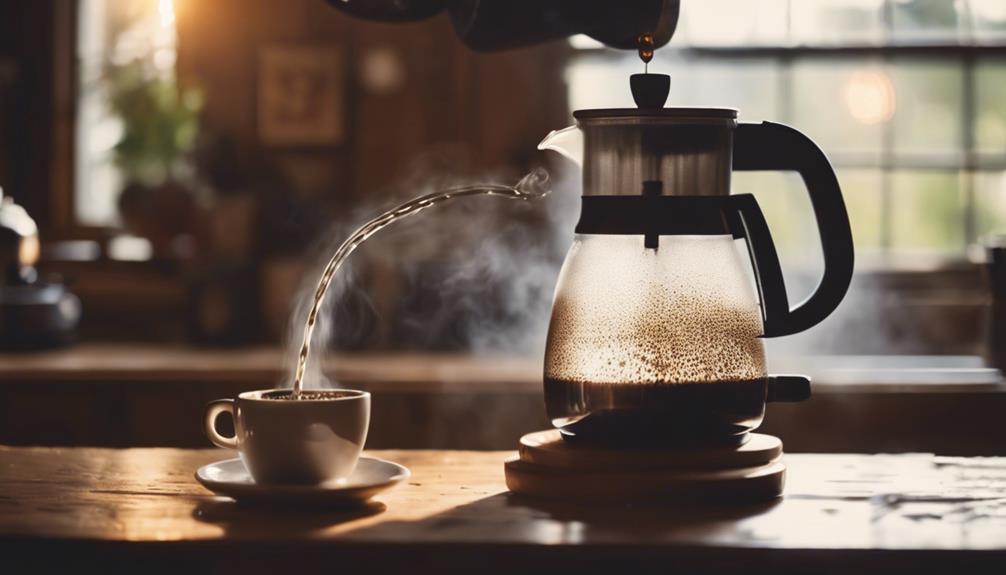
Begin by heating your water to the ideal brewing temperature of 195°F (91°C). Achieving this critical temperature is essential for proper flavor extraction from your coffee grounds. Use a kettle or another reliable heat source to reach this temperature accurately. Once the water is ready, carefully pour the hot water over the coffee grounds in the press. This initial pour should be slow and deliberate to make sure that all the grounds are evenly saturated.
When the hot water meets the coffee grounds, it initiates the release of essential flavors and oils, contributing greatly to the brew's richness and aroma. Making sure that all grounds are evenly covered promotes thorough extraction, which is crucial for achieving a balanced and flavorful cup of coffee. The table below summarizes the key points of this step:
| Step | Action |
|---|---|
| 1 | Heat water to 195°F (91°C) |
| 2 | Use a kettle or heat source |
| 3 | Pour hot water over coffee grounds |
| 4 | Ensure even coverage for excellent flavor |
Stir the Mixture
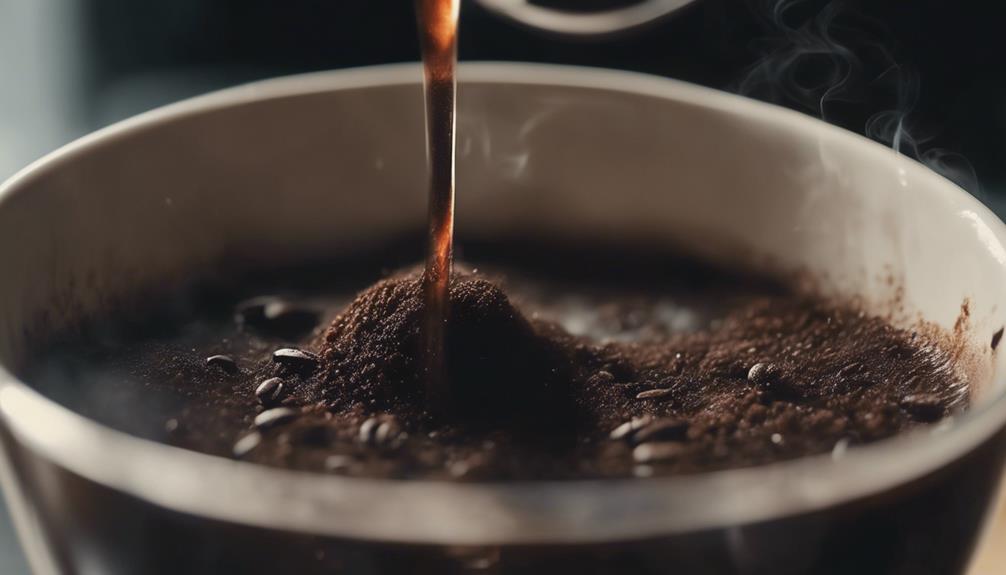
To guarantee an even extraction and full flavor, you should stir the mixture right after adding hot water.
Stirring helps distribute the coffee grounds uniformly, preventing clumps and allowing all grounds to saturate fully.
Be cautious not to over-stir, as excessive agitation can introduce bitterness to your brew.
Proper Stirring Technique
Vigorously stirring the coffee press mixture guarantees the grounds are evenly distributed and fully saturated, enhancing the overall flavor and aroma. Proper stirring is essential to break up clumps and make certain every particle of coffee makes contact with the water. Using a spoon or paddle, immerse it into the coffee press and start stirring the mixture thoroughly. This process releases aromatic compounds, contributing to a more flavorful coffee.
When employing the proper technique, aim to stir with enough vigor to mix the grounds uniformly but avoid splashing. A circular motion is often most effective, ensuring the grounds aren't just floating on the surface but fully submerged. By doing this, you promote consistent extraction, which is essential for achieving a balanced taste profile.
Proper stirring also helps optimize the brewing intensity according to your personal taste preferences. The act of stirring ensures that the coffee grounds are fully immersed, which is crucial for extracting the desired flavors.
Optimal Stirring Timing
Immediately after pouring hot water over the coffee grounds, stir the mixture to break up clumps and guarantee even extraction. This initial stirring is essential for ensuring that all the coffee grounds are thoroughly saturated, which promotes a consistent brew. Proper stirring helps release essential flavors and oils from the coffee grounds into the water, enhancing the richness and complexity of your cup of coffee.
Timing is everything when it comes to stirring in the coffee press process. By stirring immediately after adding the hot water, you're ensuring that the coffee grounds begin to release their flavors and oils right from the start. This early agitation aids in the even extraction of these compounds, which is crucial for producing a well-balanced and flavorful brew.
When you stir the mixture properly, you're not just mixing the coffee grounds with water; you're actively facilitating the extraction process. This even distribution of grounds prevents any potential pockets of dry coffee, ensuring every particle is contributing to the final flavor profile. Consequently, this method helps you achieve a consistent and high-quality cup of coffee, every time.
Benefits of Stirring
When you stir the coffee press mixture, you ensure that all the grounds are evenly distributed, leading to a balanced and flavorful brew. Stirring the mixture vigorously in your French Press Coffee Maker is essential for breaking up the grounds and making sure they don't clump together. This step is important for promoting a consistent brewing process, which is one of the key aspects of efficient brewing methods that use immersion techniques.
By stirring, you optimize the extraction of flavors and aromas from the coffee grounds, greatly enhancing the overall coffee taste. This process allows water to saturate each particle of coffee uniformly, ensuring that no grounds remain dry or under-extracted. Consequently, you achieve a more complete and flavorful extraction, resulting in a well-balanced and satisfying coffee experience.
Proper stirring before steeping not only aids in the even distribution of the coffee grounds but also ensures uniform saturation. This uniformity is crucial because it contributes directly to the robustness and complexity of the brew, making it far superior to preparations where stirring is neglected.
Incorporating vigorous stirring into your routine can significantly elevate your French Press coffee, making sure each cup is consistently delightful.
Steep the Coffee
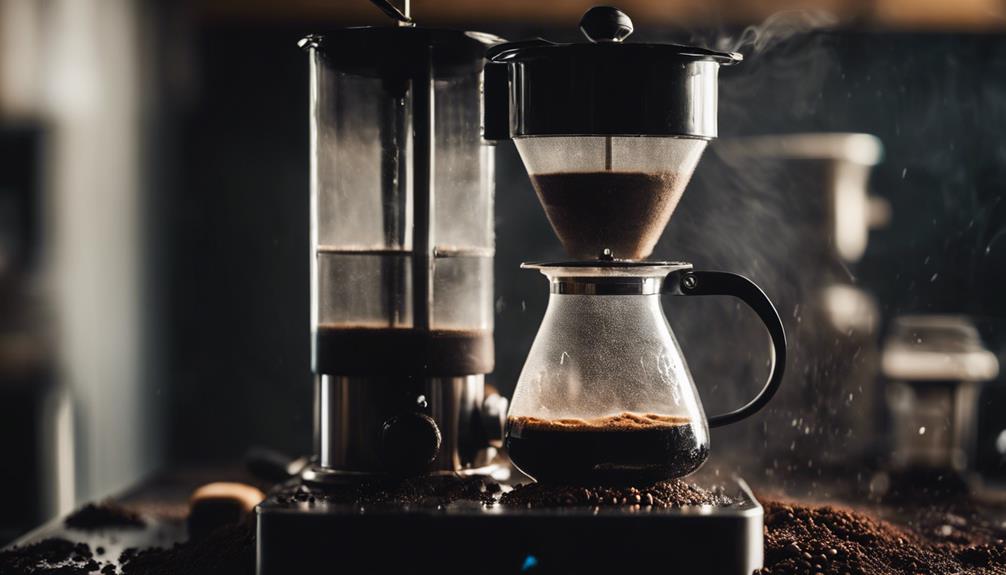
Steeping the coffee grounds in hot water lets you extract the rich flavors and aromas essential for a full-bodied brew. During the steeping process, the hot water interacts with the coffee grounds, allowing the release of oils and various compounds that contribute to the coffee's depth and complexity.
The steeping time can vary depending on your personal taste preferences, but it's important for achieving the desired strength and taste. Typically, a steeping time of around four minutes is recommended to develop a full-bodied flavor profile without over-extracting bitter compounds.
As you steep, you'll notice the water gradually turning darker, indicating the infusion of rich flavors from the grounds. The duration of steeping directly influences the coffee's final taste; a shorter steeping time results in a milder brew, while a longer steeping period can lead to a more robust and intense cup.
However, be cautious not to over-steep, as this can introduce undesirable bitterness. Ensuring an ideal steeping time is essential for balancing the extraction of flavors, resulting in a well-rounded and satisfying coffee experience. Remember, the art of steeping lies in finding that perfect balance to suit your taste.
Press the Plunger
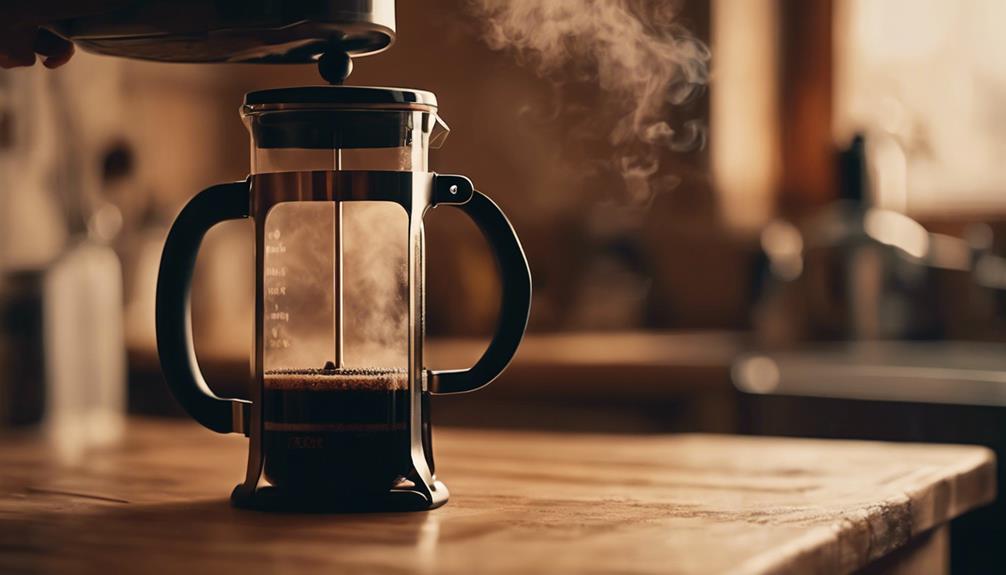
To complete the brewing process, gently press the plunger down to separate the grounds from the coffee. The plunger features a filter that's designed to push the grounds to the bottom of the press, while allowing the brewed coffee to pass through smoothly. When you press the plunger, make sure that you apply firm but not excessive pressure. This action ensures a smooth extraction process, preventing the grounds from escaping through the filter and into your brewed coffee.
It's vital to operate the plunger with care. Pressing it too quickly can lead to agitation of the grounds, which could result in a bitter taste due to over-extraction. Conversely, pressing too slowly mightn't effectively separate the grounds, leaving sediment in your cup. By maintaining a steady, controlled motion, you help ensure that the filter effectively separates the grounds from the liquid coffee, resulting in a well-brewed cup.
Properly plunging the filter is essential for achieving the desired flavor profile. By following these steps, you can make sure that your brewed coffee is smooth and free of unwanted grounds, providing a satisfying and enjoyable coffee experience.
Serve and Enjoy
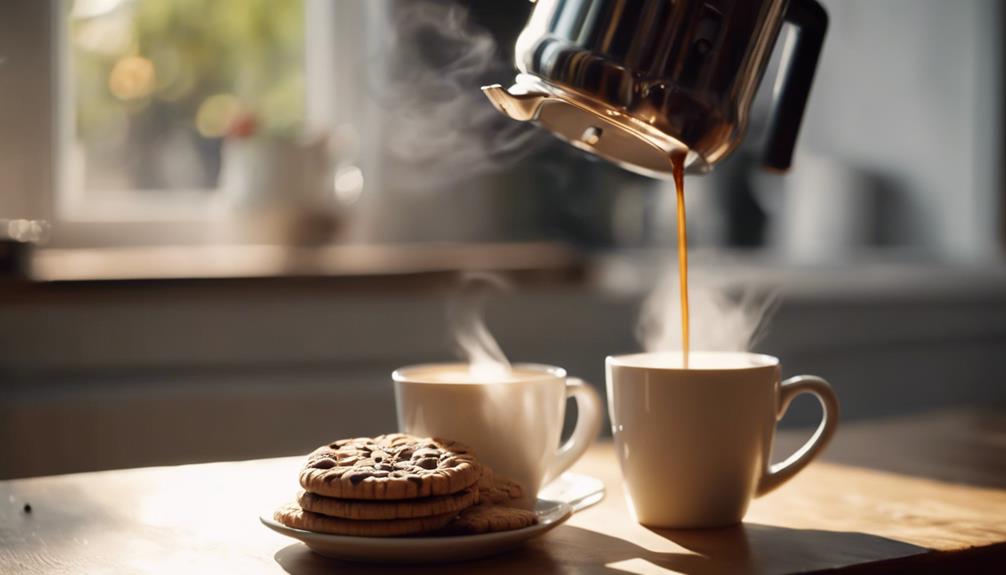
After you've pressed the plunger, immediately pour the freshly brewed coffee to maintain its peak flavor and aroma. This step is crucial as leaving the coffee in the press can lead to over-extraction, resulting in bitterness. Serving the coffee right away guarantees you capture the best flavor and aroma, allowing you to fully appreciate the rich, robust taste that characterizes French Press coffee.
To help you serve immediately and enjoy your coffee to its fullest, follow these steps:
| Step | Action | Purpose |
|---|---|---|
| 1 | Plunger pushed | Separate grounds from coffee |
| 2 | Pour immediately | Maintain best flavor |
| 3 | Serve right away | Prevent bitterness |
| 4 | Enjoy | Savor the full-bodied taste |
The immersion brewing method used in a French Press allows the coffee to develop a full-bodied and aromatic profile, making it a delightful experience. When you serve immediately after the plunger is pushed, you're ensuring that the coffee remains fresh and enjoyable. This method not only highlights the coffee's richness but also preserves its delicate nuances, providing a well-rounded and satisfying cup. So, take a moment to savor the full-bodied and aromatic experience of your freshly brewed French Press coffee.
Frequently Asked Questions
How Does a Coffee Press Work?
A coffee press operates by immersing coarsely ground coffee beans in hot water, typically around 200°F, to extract flavor.
After steeping for about four minutes, you press the plunger down, which uses a metal mesh filter to separate the grounds from the brewed coffee.
This method extracts more oils and sediments, creating a robust flavor.
Serve the coffee immediately to avoid over-extraction.
What Are the Steps in Using a Coffee Maker?
Imagine the aroma of fresh coffee filling your kitchen.
To use a coffee maker, start by adding water to the reservoir.
Then, place a filter in the basket and add your ground coffee.
Close the lid and turn the machine on.
The water heats, passing through the coffee grounds and filter, dripping into the carafe.
In minutes, you'll have a pot of delicious coffee ready to enjoy.
How Do You Make French Press Coffee Steps?
To make French press coffee, follow these steps:
Measure 1 tablespoon of coarse ground coffee per 6 fluid ounces of water.
Heat the water to 200°F and pour it over the coffee grounds in the press.
Stir gently and let it steep for about four minutes.
Slowly press down the plunger to separate the grounds from the coffee.
Pour the coffee immediately for best flavor.
How Do You Use a Simple Coffee Press?
Imagine your coffee press as a bridge between beans and brew. To use it, measure coarsely ground coffee and hot water into the beaker.
Stir the mixture, then steep for a few minutes. Slowly press the plunger down to separate the grounds from the liquid.
This method guarantees a rich, flavorful coffee, allowing you to adjust strength and taste to your preference.
Can I Use a Regular Coffee Press for Making French Press Coffee?
Yes, you can use a regular coffee press for making French press coffee. The process and the result will be similar to how French press coffee makers work. Just add coarsely ground coffee to the press, pour hot water, let it steep, and press the plunger down slowly. Enjoy your homemade French press coffee!
Conclusion
Now that you've mastered the steps of using a coffee press, you're practically a barista! From gathering your materials to serving the perfect cup, you've got it all down.
Each step guarantees you're extracting the maximum flavor and aroma from your coffee grounds. So go ahead, press that plunger with confidence and savor every sip of your expertly brewed coffee.
Remember, the secret to a great cup lies in the details, and you've nailed them all!
French Press
How Does the French Press Coffee Pot Work?
What makes the French Press coffee pot unique in delivering a rich, full-bodied brew? Discover the secrets behind its simple yet effective process.
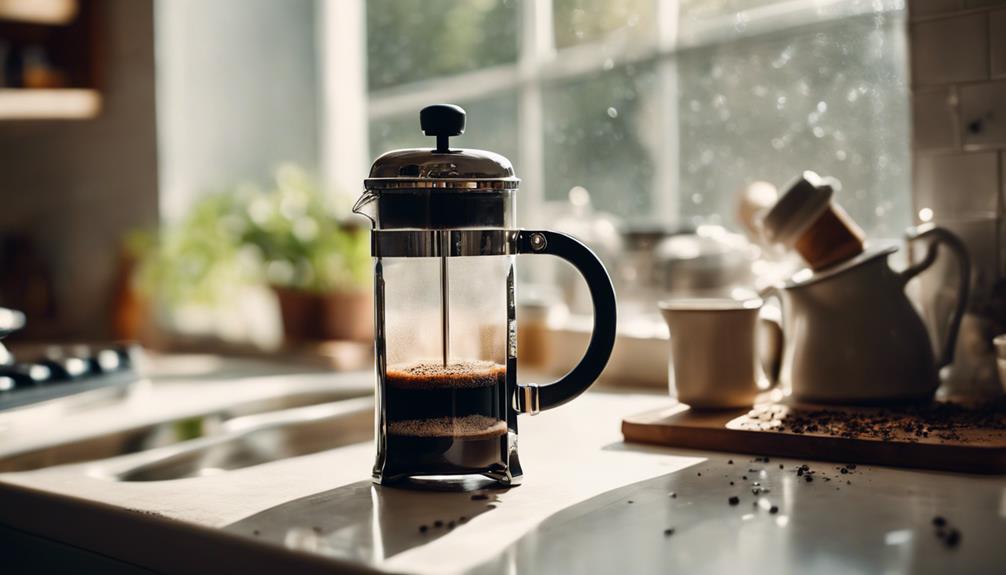
A French Press coffee pot immerses coarsely ground coffee beans in hot water, typically around 200°F, to brew. You add the grounds to the beaker, pour hot water over them, ensuring they're fully saturated, and steep for about four minutes. The plunger, equipped with a metal mesh filter, is then pressed down to separate the coffee from the grounds. This design allows essential oils and fine particles to pass through, resulting in a full-bodied flavor. Proper grind size and timing are essential to prevent over-extraction and bitterness. To understand the nuances of each step, consider the specific techniques employed.
Key Takeaways
- Coarsely ground coffee and hot water steep together in the beaker for about four minutes.
- The plunger with a metal mesh filter is pressed down to separate the grounds from the brewed coffee.
- The metal filter allows essential oils and fine particles to pass through for a full-bodied flavor.
- The lid prevents grounds from escaping into the coffee when pouring.
- The French Press offers control over steeping time, impacting the strength and flavor of the coffee.
French Press Components
The French Press is composed of a beaker, plunger, and filter, each playing an essential role in the brewing process. These components work together to create a unique and rich coffee experience.
The French press coffee maker's beaker, typically made of glass or stainless steel, holds the hot water and coffee grounds. It's designed to withstand high temperatures and allows you to observe the brewing process.
The plunger is connected to a metal rod and is essential for pressing the coffee grounds to the bottom of the beaker. Attached to the plunger is a metal filter, which plays a critical role. Unlike paper filters, this metal filter allows the natural oils and fine particles from the coffee grounds to pass through, giving French press coffee its distinct texture and flavor.
The lid of the French press fits securely onto the beaker, ensuring that no coffee grounds escape during brewing. Additionally, the handle is ergonomically designed to allow for easy and safe pouring of the brewed coffee.
Each of these components—the beaker, plunger, metal filter, lid, and handle—comes together to make the French press coffee maker a highly effective tool for brewing rich, flavorful coffee.
Brewing Process Overview
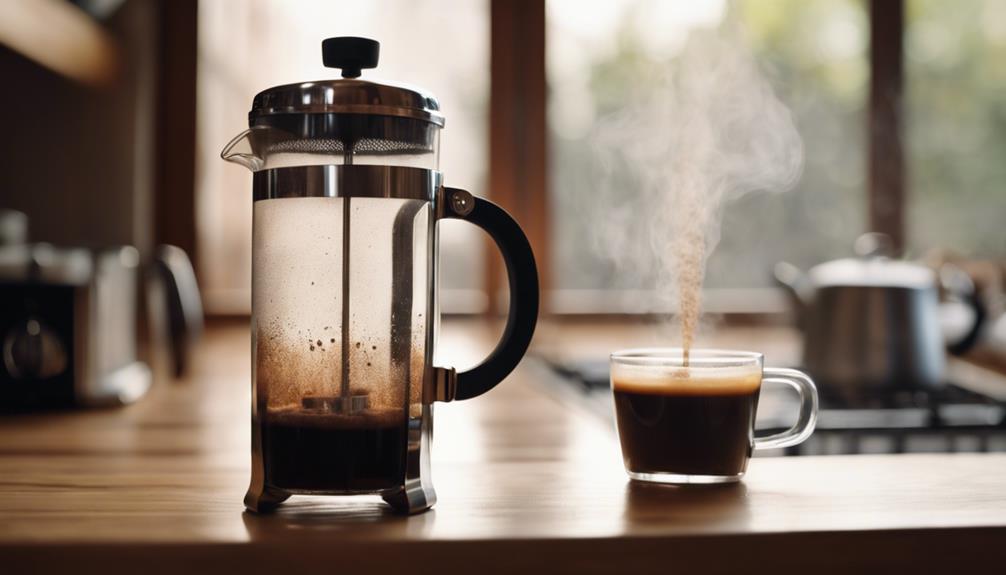
Brewing coffee with a French press involves steeping coarsely ground beans in hot water, guaranteeing a rich and robust flavor. To get started, use French press recipes that call for coarse-ground coffee, as finer grinds can clog the metal mesh filter.
Begin by heating water to around 200°F, which is perfect for ideal flavor extraction. Pour the hot water over the coarse-ground coffee in the French press, and stir gently to make sure all the grounds are fully saturated.
The immersion brewing method is employed here, meaning the coffee grounds remain in contact with the hot water throughout the brewing process. This method ensures consistent flavor extraction, allowing the coffee's natural oils and flavors to fully develop.
Let the coffee steep for about four minutes, a standard time recommended in many French press recipes.
After steeping, press down the plunger slowly and steadily. The metal mesh filter attached to the plunger will separate the grounds from the brewed coffee, allowing you to enjoy a cup free from sediment.
This process not only allows for full control over the brewing process but also results in a rich and robust coffee flavor that many enthusiasts appreciate.
Required Equipment
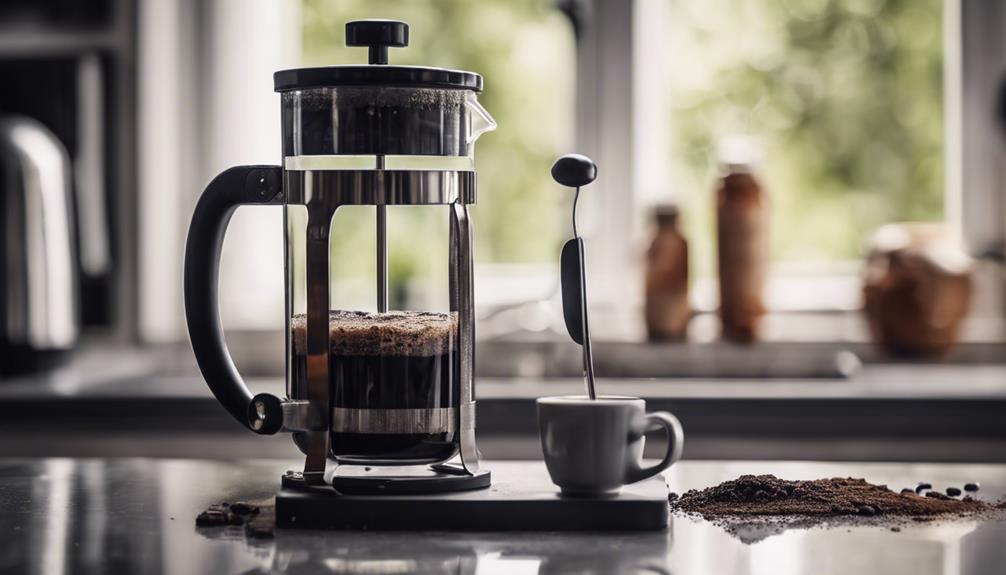
To effectively use a French Press, you'll need three essential components: the French Press itself, coarsely ground coffee, and hot water at the right temperature.
The French Press consists of a beaker, a plunger, and a metal mesh filter that work together to steep and separate the coffee grounds from the liquid.
Ensuring you have the correct coffee grounds and water temperature is vital for achieving the best flavor and extraction.
French Press Components
When you're setting up your French Press, you'll need a beaker, plunger, metal filter, and a lid to get started. These components are essential to the brewing process and guarantee you get a smooth, rich cup of coffee.
The beaker, often made of glass, metal, plastic, or ceramic, is where you combine your coffee grounds and hot water. This container must withstand high temperatures and provide a clear view of the brewing process.
The plunger, connected to the metal filter via a sturdy metal rod, is designed to press the filter down through the coffee mixture. The metal filter is vital as it separates the coffee grounds from the brewed coffee, allowing the liquid to flow through while trapping the grounds. This fine mesh ensures that your coffee is free from sediment.
Lastly, the lid fits securely onto the top of the beaker, helping to prevent heat loss and maintain ideal brewing conditions. This lid often features a small opening for pouring, making it convenient to serve your freshly brewed coffee without removing it entirely.
These components work together to create a consistent and enjoyable coffee experience.
Necessary Coffee Grounds
Now that you understand the components of a French Press, let's explore the importance of using the right coffee grounds for best brewing results.
The grind size of your coffee grounds plays a significant role in flavor extraction and the overall quality of your brew. For a French Press, you'll need coarse grounds. Coarse grounds are essential because they prevent the coffee particles from passing through the metal filter, ensuring a clean and smooth cup.
Using coarse grounds aids in a slower extraction process, allowing more of the coffee's natural oils and flavors to pass through the metal mesh filter. This results in a rich and robust flavor profile, which is the hallmark of a well-brewed French Press coffee.
On the other hand, using fine grounds can lead to over-extraction. Over-extraction occurs when the coffee grounds are too fine, causing them to dissolve too quickly and release excessive bitter compounds, thereby ruining the taste of your coffee.
Water Temperature Essentials
Achieving the ideal water temperature is crucial for brewing a delicious French Press coffee, and having the right equipment can make all the difference. The French Press requires water at around 200°F for best flavor extraction.
Water temperature greatly impacts the taste of your coffee – water that's too hot can lead to a burnt flavor, while cooler water might result in under-extraction, leaving your coffee weak and unsatisfying.
To make sure you consistently reach the ideal 200°F, consider using the following equipment:
- Thermometer: A simple kitchen thermometer can help you measure the exact temperature of your water, making sure you hit that 200°F mark every time.
- Electric Kettle with Temperature Control: This handy device allows you to set the precise temperature you need, making the process straightforward and repeatable.
- Stovetop Kettle: While less precise, you can still achieve the desired temperature by boiling water and then letting it sit for about 30 seconds.
- Insulated Carafe: Once you've heated your water, an insulated carafe can help maintain the correct temperature as you prepare your French Press.
Using the right equipment ensures your water temperature is perfect, enhancing the taste of your French Press coffee and avoiding issues like burnt flavor or under-extraction.
Coffee to Water Ratio
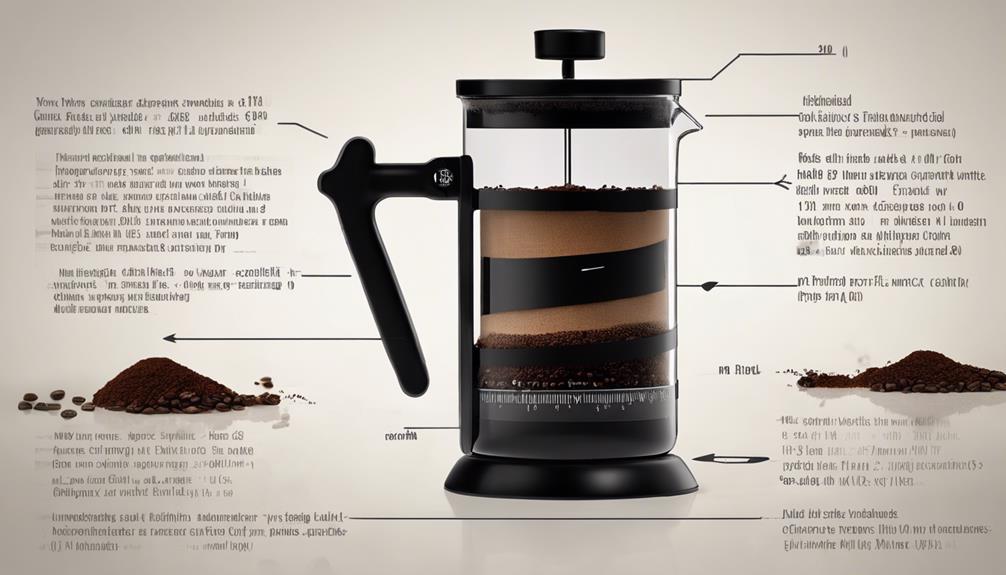
When preparing French press coffee, the ideal coffee to water ratio is 1:16, which means using 1 gram of coffee for every 16 grams of water.
Adjusting this ratio allows you to control the strength and flavor of your brew, catering to personal preferences.
Using a scale to measure both ingredients guarantees consistency and helps achieve a balanced, flavorful cup every time.
Ideal Brewing Measurements
Finding the perfect coffee to water ratio is key to brewing a delicious cup of French press coffee. The ideal measurements for the French press typically follow a coffee to water ratio of 1:16, which translates to 1 gram of coffee for every 16 grams of water. This ratio serves as a foundational guideline, ensuring a balanced and flavorful cup. During the brewing process, adhering to this ratio allows for the best extraction of coffee flavors, enhancing the overall flavor profile.
However, you can adjust ratios based on personal taste preferences. If you're aiming for a stronger brew, you might use a ratio of 1:15, while a milder cup could call for a 1:17 ratio. This customization lets you fine-tune the coffee's strength and flavor according to your liking.
To paint a clear picture, here are the steps for ideal brewing measurements:
- Measure your coffee beans: Use a kitchen scale to weigh out your coffee beans accurately.
- Grind the coffee: Coarsely grind the measured coffee beans for best extraction.
- Boil water: Heat the water to the appropriate temperature, typically just off the boil.
- Combine and brew: Add the coffee grounds to the French press, pour in the water, and let it steep for about four minutes.
Adjusting Strength Preferences
You can easily adjust the strength of your French press coffee by tweaking the coffee-to-water ratio to suit your taste preferences. The standard ratio of 1:16, where 1 gram of coffee is used for every 16 grams of water, serves as a baseline. However, adjusting this ratio can help you personalize the flavor profile to achieve your desired strength.
To fine-tune your coffee, consider experimenting with different ratios. A higher coffee-to-water ratio results in a stronger brew, while a lower ratio yields a milder cup. Consistency in your measurements is vital to achieving the same strength and flavor each time you brew.
Here's a guide to help you adjust the coffee-to-water ratio:
| Coffee (grams) | Water (grams) | Strength |
|---|---|---|
| 1 | 16 | Standard |
| 1 | 14 | Stronger |
| 1 | 18 | Milder |
| 1 | 12 | Very Strong |
| 1 | 20 | Very Mild |
Experimentation is key to discovering what suits your palate best. By meticulously adjusting the ratio, you can guarantee that each cup of French press coffee matches your strength preferences, offering a consistent and enjoyable flavor profile every time.
Standard Proportion Guidelines
Understanding the standard coffee-to-water ratio is essential for brewing a well-balanced and flavorful French press coffee. The recommended ratio is 1:16, meaning 1 gram of coffee to 16 grams of water. This foundational guideline guarantees a balanced extraction, allowing the coffee's intricate flavors to shine.
Here's how you can apply this ratio:
- Measure the Coffee: Use a scale to measure 1 gram of coffee for every 16 grams of water you plan to use.
- Adjust Ratio: If you prefer a stronger brew, you can experiment with different ratios, such as 1:15 or even 1:14.
- Customize Coffee Strength: For a milder cup, try a 1:17 or 1:18 ratio to find your ideal flavor profile.
- Proportioning Coffee: Properly proportioning coffee to water is vital, so always measure accurately to achieve consistent results.
Heating the Water

To achieve the perfect brew, start by heating your water to around 200°F. This temperature is essential for your French Press as it guarantees the coffee grounds steep properly, leading to ideal flavor extraction. If your water is too hot, reaching the boiling point of 212°F, it can burn the coffee grounds, resulting in a bitter taste. Conversely, if the water is too cool, it won't extract the flavors adequately, leaving you with a weak, underwhelming cup.
You can heat your water on a stove or use an electric kettle. Both methods are effective, but make sure to monitor the water temperature closely. Using a thermometer can help you achieve the precise 200°F needed.
Here's a quick guide to water temperatures and their effects:
| Water Temperature | Effect on Coffee | Ideal for French Press? |
|---|---|---|
| 212°F | Burns grounds | No |
| 200°F | Optimal extraction | Yes |
| 190°F | Under-extracted | No |
| 180°F | Weak flavor | No |
| Room Temp | No extraction | No |
Grinding the Coffee
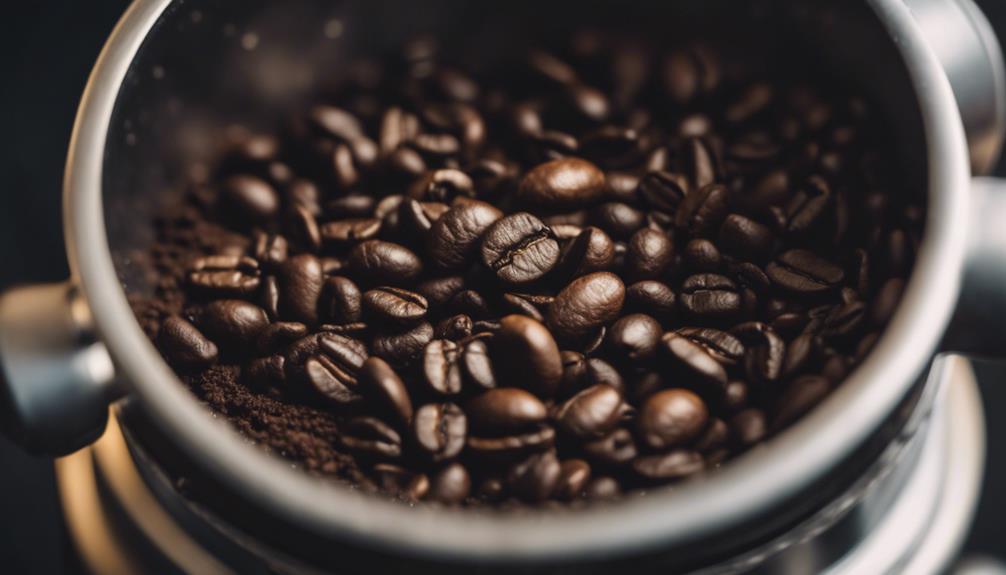
After heating your water to the perfect temperature, the next step is grinding the coffee beans to the right consistency. For a French Press, a coarse grind is essential to prevent grounds from passing through the filter, guaranteeing a clean cup of coffee. Coarse grinds allow for a slower extraction process, which enhances flavor extraction, resulting in a more flavorful and robust brew.
Grinding coffee too fine can lead to over-extraction, causing a bitter taste in your final cup. The recommended grind size for a French Press is similar to breadcrumbs, striking the ideal balance for best flavor extraction. Consistency and uniformity in your coffee grind are critical to achieving a balanced and rich coffee flavor.
To help you visualize the process, here's a quick guide:
- Select Quality Beans: Start with fresh, whole coffee beans for the best flavor.
- Set Your Grinder: Adjust your grinder to a coarse setting, aiming for a grind size similar to breadcrumbs.
- Grind Consistently: Ensure all your coffee grounds are uniform to avoid over or under-extraction.
- Measure Correctly: Use the right coffee-to-water ratio, typically one ounce of coffee to 15 ounces of water.
Combining Ingredients
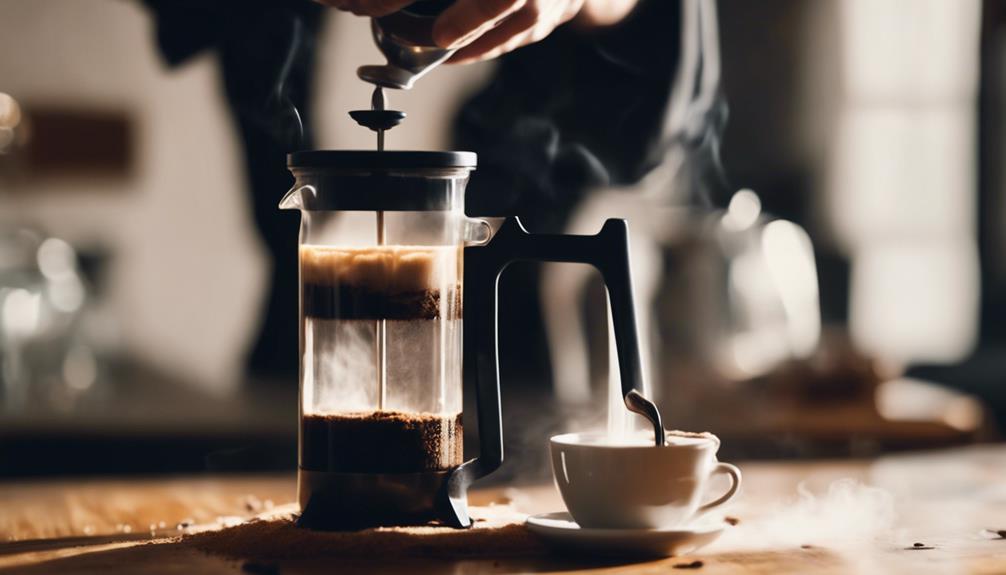
Start by pouring the coarse-ground coffee into the French press beaker. Ensuring that the coffee grounds are coarse is essential, as it allows for proper extraction of flavors without clogging the metal mesh filter.
Once the coffee grounds are in the beaker, it's time to pour hot water over them. The water should be just below boiling, around 200°F (93°C), to optimize the infusion process.
Carefully pour hot water in a steady stream, making sure all the grounds are fully saturated. This step is vital for allowing the flavors to infuse effectively. As the hot water mingles with the coarse-ground coffee, the brewing process begins, releasing the rich, aromatic characteristics of the coffee beans.
Next, place the lid on the French press with the plunger pulled all the way up. The metal mesh filter attached to the plunger will eventually be used to separate the brewed coffee from the grounds. However, for now, let the mixture sit undisturbed. This phase is crucial for achieving a well-balanced liquid coffee. The flavors from the coffee grounds will continue to infuse into the water, preparing for the final pressing step.
Steeping and Timing

Steeping your coffee grounds for the right amount of time, typically 3 to 4 minutes, is crucial for achieving a balanced and flavorful cup. The steeping time in a French Press directly affects the best extraction of flavors from the coffee grounds.
Here's what you need to know to guarantee a well-balanced brew:
- Measure Your Coffee and Water: Use a ratio of about 1:15 (coffee to water). For instance, 30 grams of coffee to 450 grams of water.
- Set a Timer: Start your timer as soon as you pour hot water over the coffee grounds. This ensures that your steeping time is accurate.
- Monitor the Steeping: Keep an eye on the time to avoid over-extraction, which can lead to bitterness. A steeping time beyond 4 minutes can negatively impact the flavor.
- Prepare for Plunging: After the steeping time, use the metal mesh filter to separate the grounds from the liquid by slowly pressing down the plunger.
Pressing and Serving

Pressing down the plunger in a French Press separates the coffee grounds from the brewed coffee, guaranteeing a smooth and flavorful pour. This action is vital for achieving a well-balanced cup. The plunger, equipped with a metal mesh filter, allows the liquid coffee to pass through while effectively trapping the grounds. By pressing the filter to the bottom of the beaker, you ensure that the coffee remains free of sediment, resulting in a clean and enjoyable beverage.
Once the plunger is fully depressed, serving the coffee immediately is crucial. Delaying this step can lead to over-extraction, which occurs when the coffee grounds remain in contact with the water for too long, resulting in a bitter and unpleasant taste. Therefore, prompt serving is key to maintaining the ideal flavor profile of your brewed coffee.
The design of the French Press facilitates easy and efficient serving. As you pour, the metal mesh filter ensures that no grounds escape into your cup, providing a sediment-free experience. This method not only enhances the overall quality of the coffee but also simplifies the serving process, making the French Press a preferred choice for many coffee enthusiasts.
Frequently Asked Questions
How Does the French Press Coffee Maker Work?
The French press coffee maker operates by immersing coarse coffee grounds in hot water, typically around 200°F, allowing them to steep for several minutes.
You then press a metal mesh filter through the mixture, effectively separating the grounds from the brewed coffee.
This immersion brewing method guarantees a consistent extraction of flavors, resulting in a rich and robust coffee.
Importantly, the French press doesn't require electricity, making it a straightforward and effective brewing method.
Why Use a French Press Instead of Coffee Maker?
Imagine waking up to the rich aroma of coffee oils and flavors that a French Press captures, unlike drip coffee makers.
You gain full control over brewing variables, ensuring a customized experience.
It's versatile for cold brews, teas, or herbal infusions. Plus, it's eco-friendly since you're not using paper filters.
A French Press not only enriches taste but also promotes sustainability, making it a superior choice.
Do You Need Coffee Filters for a French Press?
You don't need coffee filters for a French Press because it uses a built-in metal mesh filter. This filter allows natural oils and fine particles to pass through, enhancing the coffee's flavor and texture.
The plunger with the metal mesh filter efficiently separates the grounds from the liquid, resulting in a rich and robust coffee. Therefore, the absence of paper filters contributes to a fuller-bodied coffee experience.
Can You Use Regular Ground Coffee in a French Press?
Yes, you can use regular ground coffee in a French press, but there's a catch. Regular ground coffee might lead to over-extraction and a gritty texture that diminishes the experience.
For the best results, choose coarser ground coffee. It allows for ideal flavor extraction and minimizes the silty residue at the bottom of your cup, ensuring a clean and flavorful brew every time.
What are the Steps for Using a French Press Coffee Pot?
To use a French press coffee pot, start by adding coarse coffee grounds to the pot. Then, pour hot water over the grounds, stir, and let it steep for about four minutes. After that, press down the plunger slowly to separate the grounds from the coffee. That’s the coffee press operation explained.
Conclusion
Just as an artist combines colors to create a masterpiece, using a French press requires precise steps. By understanding each component and following the brewing process closely, you'll produce a rich, flavorful coffee.
From the accurate coffee-to-water ratio to the exact timing for steeping, each detail matters. Embrace this method, and you'll appreciate how its simplicity belies the complexity behind a perfect cup.
Mastery of the French press is truly an art in itself.
-

 Coffee Guides2 weeks ago
Coffee Guides2 weeks agoBoost Your Coffee: Easy Ways to Enhance Your Brew
-
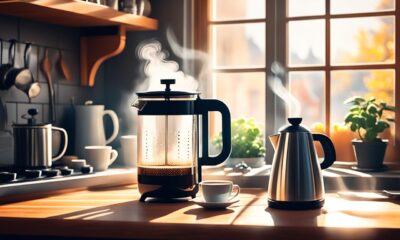
 Coffee Guides2 weeks ago
Coffee Guides2 weeks agoBrew Perfect Coffee at Home: Expert Tips & Tricks
-

 Health and Wellness2 weeks ago
Health and Wellness2 weeks agoHeadache-Free: How to Avoid Coffee Headaches!
-

 Vetted2 weeks ago
Vetted2 weeks ago15 Best Trundle Beds for Maximizing Space and Style in Your Home
-

 Coffee Guides2 weeks ago
Coffee Guides2 weeks agoBecome a Coffee Master: Expert Brewing Tips
-

 Coffee Guides2 weeks ago
Coffee Guides2 weeks agoBreve Coffee Explained: Your Cozy Café Favorite
-

 Coffee Guides2 weeks ago
Coffee Guides2 weeks agoHow to Be a Coffee Cup: Embrace Your Inner Brew
-

 Vetted2 weeks ago
Vetted2 weeks ago15 Best Cordless Pool Vacuums for Effortless Pool Cleaning























